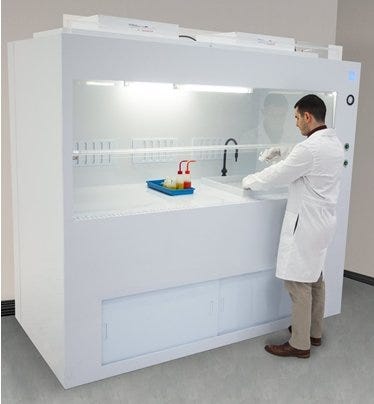What is a Semiconductor?
“Semi-conductors,” also known as integrated circuits (ICs) or chips, are components with more electrical conductivity than insulators, but less electrical conductivity than conductors, as measured by the potential activity of charged electrons. They are ubiquitous in our society: anything with an ON/OFF switch contains an integrated circuit. Metalloid elements such as the abundant silicon (Si) are used as the chips’ substrate. When manufactured, impurities are deliberately added (a process called “doping”) to alter the conductivity characteristics, making them more suitable as electronic-device components. Common dopants are arsenic or boron, each with a different quantity of outer electrons that create positive or negative charges and electron “holes.” In a move away from electronic technologies such as vacuum tubes and crystal diodes in 1958, semiconductor components have allowed companies to continually create devices that are smaller, faster and less expensive.
Semiconductor Industry
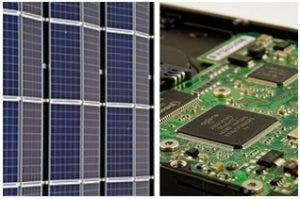
Solar cells and integrated circuits are made of silicon and manufactured using wet processing
In 2015, global revenue was $335 billion (half that belonging to US-based companies). According to the Semiconductor Industry Association, global semiconductor sales increased to $439 billion in 2020, a 6.5% year-over-year increase. According to DC forecasts, the semiconductor market will reach $476 billion in 2021, up 7.7% year over year. The Bureau of Labor Statistics estimates that there are nearly 362,450 people employed in the semiconductor and electronics industry as of 2020.
The 2016 Congressional Research Service report states that US exports of semiconductors was almost $42 billion, making the industry the country’s fourth largest export. In recent years, investments in new semiconductor equipment and factories reached about $20 billion per year.
Wafer Manufacturing
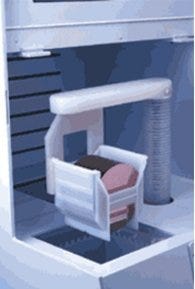
Silicon wafers are thin, round components; pictured here nested in an automated arm above a tank on a wet processing station
Integrated circuits require hundreds of individual steps to fabricate, which is why hundreds are made simultaneously. We’ll look at the equipment needed to produce wafers, the basis for making individual ICs. Wafers are thin, round “slices” that come from melting the semiconductor material (silicon in our example) at 1420°C (2588°F) to form a crystalized cylindrical block called an ingot. The block is shaped with a grinder and, like a loaf of bread, sliced into thin layers. Each wafer is about 160-300 um thick.
Wafer processing requires specialized work stations called wet chemistry benches. The processing uses specific equipment and a series of chemicals to clean, etch, mask, deposit, rinse, and dry, creating the combination of patterned layers that will eventually become electronic chips. A number of baths, tanks, rinsers, circulators, spray guns, temperature controllers and other modules are assembled together on the bench surface to establish an efficient front-end wafer process flow. It’s critical to minimize chemical carry-over between steps, and prevent contaminants from being introduced. To that end, some wet chemical steps are filtered to remove particulates.
Wet Processing Stations
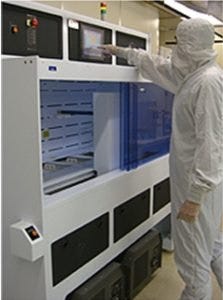
Automated wet processing station with control panel
Wet bench design and material is specific to the application; chemicals including sodium hydroxide, potassium hydroxide and nitric acid are caustic and can cause damage. When using acids and bases, polypropylene is the best material, while stainless steel is necessary for solvents. Stations from Terra include:
- Cleaning
- Integrated Station
- Modular Station
- Solvent Spray Booth
- Wafer Processing
- Manual Bench
- Semi-Automated Station
- Fully Automated Station
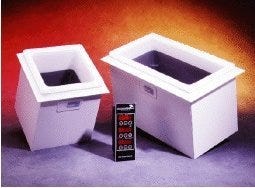
Ultra-pure Quartz baths suitable for chemical etching, stripping and cleaning processes
Cleaning stations are designed specifically for cleaning semiconductor components, including wafers and solar cells. They are made of polypropylene and configured with sinks, faucets, and DI water and nitrogen spray guns. Deck surfaces are perforated to allow run-off of spilled acids which are collected in carboys for safe disposal. Filter units may be added to exhaust fumes from the work area. The integrated bench comes with the processing station and built-in overhead light and filter module, while the modular bench is ordered as separate components.
The Solvent Spray Booth is made of stainless steel for applications using flammable or corrosive chemicals. It can be equipped with explosion-proof light and fire sprinklers. The booth features a split perforated sink that drains into carboys, faucets and petcocks that deliver solvents for rinsing, and nitrogen for drying; adjustable pressure gauges control force of flow, and hands-free pneumatic foot pedals in front of each sink turn them on and off.
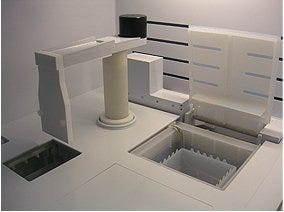
Teflon tank (R) and automated arm (L) in semi-automated wet processing work station. Teflon used for acid etching of wafers
Wafer processing stations also contain cleaning modules, but the layering needed for proper IC function, whether it be by adding or removing material, is the primary purpose. Terra wet processing stations are manual, semi-automated or fully automated to meet the needs of all applications and budgets. All benches contain the same OSHA and NFPA safety features, and can be made of acid-resistant polypropylene or solvent-friendly stainless steel. In the semi-automated station, a touchscreen monitor controls robotics to increase efficiency, throughput and accuracy. Manufacturers needing the highest, most consistent yield will use fully-automated stations with a high-level of control for walk-away activities. Automated stations can be connected to waste systems for safer collection, neutralization and disposal.
Other dedicated stations can interface with the processing benches to add functionality and streamline the fabrication: drying stations, fume scrubber, chemical storage and delivery systems, fire detection systems, and more.
Conclusion
When configuring modular wet bench components on front-end wafer processing benches, consideration must be made to the types of modules, and their arrangement. Each wet processing station can be made to manufacturer specifications. As reported by the Congressional Research Service report, companies continue to invest in wet processing and export integrated circuits. The electronic and digital world depends on precisely made microchips. The stations mentioned here are high-quality, factory tested and designed by experienced professionals.
Find Wet Processing Stations and Modules atTerra Universal.



